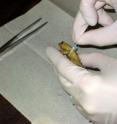Preserved frogs hold clues to deadly pathogen
A Yale graduate student has developed a novel means for charting the history of a pathogen deadly to amphibians worldwide. Katy Richards-Hrdlicka, a doctoral candidate at the Yale School of Forestry & Environmental Studies, examined 164 preserved amphibians for the presence of Batrachochytrium dendrobatidis, or Bd, an infectious pathogen driving many species to extinction. The pathogen is found on every continent inhabited by amphibians and in more than 200 species. Bd causes chytridiomycosis, which is one of the most devastating infectious diseases to vertebrate wildlife.
Richards-Hrdlicka swabbed the skin of 10 species of amphibians dating back to 1963 and preserved in formalin at the Peabody Museum of Natural History. Those swabs were then analyzed for the presence of the deadly pathogen.
"I have long proposed that the millions of amphibians maintained in natural-history collections around the world are just waiting to be sampled," she said.
The samples were then analyzed using a highly sensitive molecular test called quantitative polymerase chain reaction (qPCR) that can detect Bd DNA, even from specimens originally fixed in formalin. Formalin has long been recognized as a potent chemical that destroys DNA.
"This advancement holds promise to uncover Bd's global or regional date and place of arrival, and it could also help determine if some of the recent extinctions or disappearances could be tied to Bd," said Richards-Hrdlicka. "Scientists will also be able to identify deeper molecular patterns of the pathogen, such as genetic changes and patterns relating to strain differences, virulence levels and its population genetics."
Richards-Hrdlicka found Bd in six specimens from Guilford, Conn., dating back to 1968, the earliest record of Bd in the Northeast. Four other animals from the 1960s were infected and came from Hamden, Litchfield and Woodbridge. From specimens collected in the 2000s, 27 infected with Bd came from Woodbridge and southern Connecticut. In other related work, she found that nearly 30 percent of amphibians in Connecticut today are infected, yet show no outward signs of infection.
Amphibian populations and species around the world are declining or disappearing as a result of land-use change, habitat loss, climate change and disease. The chytrid fungus, caused by Bd, suffocates amphibians by preventing them from respiring through their skin. Since Bd's identification in the late 1990s, there has been an intercontinental effort to document amphibian populations and species infected with it. Richards-Hrdlicka's work will enable researchers to look to the past for additional insight into the pathogen's impact.
Richards-Hrdlicka's paper, "Extracting the Amphibian Chytrid Fungus from Formalin-fixed Specimens," appears in the journal Methods in Ecology and Evolution.
Source: Yale University
Other sources
- Museum work could fight amphibian diseasefrom UPIFri, 22 Jun 2012, 1:00:42 UTC
- Museum work could fight amphibian diseasefrom UPIWed, 20 Jun 2012, 21:30:22 UTC
- Preserved frogs hold clues to deadly pathogenfrom Science DailyWed, 20 Jun 2012, 17:00:40 UTC
- Preserved frogs hold clues to deadly pathogenfrom PhysorgWed, 20 Jun 2012, 15:30:47 UTC
